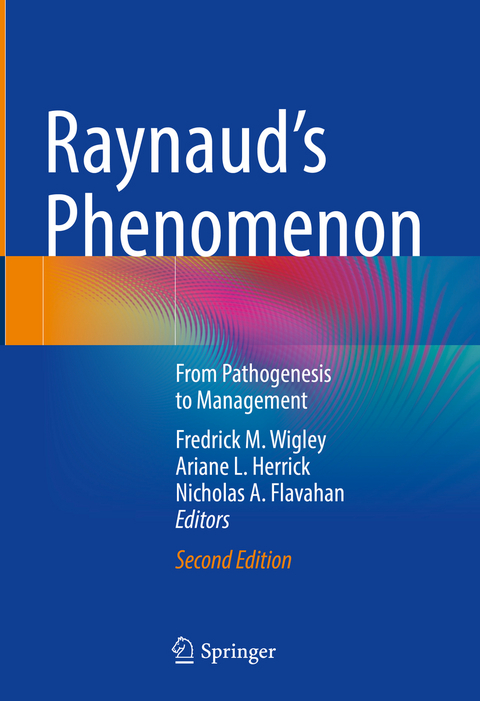
Raynaud’s Phenomenon
Springer International Publishing (Verlag)
978-3-031-52580-3 (ISBN)
This book comprehensively reviews the understanding of a disorder that continues to challenge primary care clinicians and specialists. Raynaud's phenomenon is an inappropriate and exaggerated response of the digital and cutaneous circulation to cold environmental temperatures. It is common, often causing significant morbidity and it is a major challenge for physicians at every level and specialty. A comprehensive review of Raynaud's is now timely because of the incredible progress in understanding the molecular mechanisms of the normal regulation of cutaneous blood flow and how disease can disrupt the function of these specialized vessels. Likewise, the clinical implications of Raynaud's phenomenon are better appreciated with studies defining its prevalence, the associated diseases, and new treatment approaches for patients suffering from it. The nomenclature used to classify cases has changed over the years and is important to understand these terms both for clinical care andresearch.
This fully updated second edition comprehensively discusses various causes of Raynaud's phenomenon including childhood Raynaud's phenomenon, Raynaud's phenomenon secondary to connective tissue disease, occupational causes, and a variety of other associated disorders. Careful consideration is given to the diagnosis of Raynaud's phenomenon with state of the art discussion of nailfold capillary examination, non-invasive imaging, angiography, and appropriate serological testing. The concept that Raynaud's phenomenon is associated with systemic disease or can be the manifestation of a systemic vasospastic disorder is also presented. In addition to reviewing both non-drug and drug therapy for patients with Raynaud's phenomenon, this volume provides a practical approach in specific clinical situations by presenting problematic cases and the authors' expert opinions on therapy. It also discusses mechanisms contributing to the vascular dysfunctionof primary Raynaud's phenomenon and the vascular disease of secondary Raynaud's phenomenon.
Engaging readers with case vignettes and a plethora of visual aids, Raynaud's Phenomenon: From Pathogenesis to Management is a state-of-the-art, authoritative reference and invaluable contribution to the literature that will be of interest to adult and pediatric physicians, rheumatologists, and clinical and basic researchers.
Fredrick M Wigley has specialized in studies related to systemic sclerosis (scleroderma) and Raynaud's phenomenon for over 30 years and has vast experience in managing patients with Raynaud's. He is an author on over 250 peer-reviewed manuscripts. He has been Associate Editor of Arthritis and Rheumatology and principal author of the in Raynaud' section in Up-to Date. He was given the American College of Rheumatology (ACR) Distinguished Clinician Scholar Award in 2009 and was recognized as a Master by the ACR in 2011.
Fredrick M. Wigley, M.D.
Johns Hopkins University
School of Medicine
Baltimore, MD
USA
Ariane L. Herrick, M.D., FRCP
Division of Musculoskeletal and Dermatological Sciences,
The University of Manchester,
Manchester,
UK
Nickolas Flavahan is a professor of anesthesiology and critical care medicine at the Johns Hopkins University School of Medicine. His research has focused on elucidating the cellular interactions and subcellular signalling pathways that control normal vascular function and those that regulate the initiation of vascular disease. He has spent a large part of his career investigating the cutaneous circulation, uncovering numerous aspects of its unique biology including the molecular mechanisms underlying cold-induced vasoconstriction.
Nicholas Flavahan, Ph. D.
Johns Hopkins University
School of Medicine
Baltimore, MD
USA
Chapter 1: Historical perspective of Raynaud's phenomenon.- Chapter 2: Definition, Nomenclature and Diagnostic criteria.- Chapter 3: Epidemiology of Raynaud's Phenomenon.- Chapter 4: The Normal Structure and Function of the Cutaneous Vascular System.- Chapter 5: A Mechanistic Approach to Understanding and Preventing the Vasculopathy of Raynaud's Phenomenon.- Chapter 6: Practical approach to the patient with Raynaud's Phenomenon: Primary versus Secondary Raynaud's Phenomenon.- Chapter 7: Raynaud Phenomenon in the Pediatric Age.- Chapter 8: Secondary Raynaud's phenomenon: focus on rheumatic diseases.- Chapter 9: Other Secondary Causes.- Chapter 10: Raynaud's Mimics.- Chapter 11: Systemic Vasospasm.- Chapter 12: Nailfold Capillaroscopy.- Chapter 13: Autoantibodies in Raynaud's Phenomenon.- Chapter 14: Angiography.- Chapter 15: Laboratory Assessment of Raynaud's Phenomenon.- Chapter 16: Statistical design and reporting of randomised controlled trials for Raynaud's Phenomenon.- Chapter 17: Clinical Outcome Measures in Raynaud's Phenomenon.- Chapter 18: Non-drug Approaches to Treating Raynaud's Phenomenon.- Chapter 19: Drug therapy.- Chapter 20: Surgical management.- Chapter 21: Digital Ulcers and Acute Digital Ischemia.- Chapter 22: Practical Approaches to Treatment: Case Studies.
| Erscheinungsdatum | 04.05.2024 |
|---|---|
| Zusatzinfo | XVII, 443 p. 118 illus., 98 illus. in color. |
| Verlagsort | Cham |
| Sprache | englisch |
| Maße | 178 x 254 mm |
| Themenwelt | Medizin / Pharmazie ► Medizinische Fachgebiete ► Dermatologie |
| Schlagworte | nailfold capillary • Raynaud's phenomenon • secondary Raynaud's phenomenon • Thermoregulation • vascular disease |
| ISBN-10 | 3-031-52580-9 / 3031525809 |
| ISBN-13 | 978-3-031-52580-3 / 9783031525803 |
| Zustand | Neuware |
| Informationen gemäß Produktsicherheitsverordnung (GPSR) | |
| Haben Sie eine Frage zum Produkt? |
aus dem Bereich


